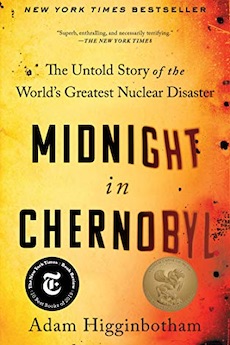By Benjamin Franklin Martin
At 1:24 AM on April 26, 1986, reactor 4 of the Chernobyl nuclear generating facility experienced an uncontrollable accident. The reactor’s core reached a temperature of 10,000 degrees centigrade, almost twice that on the surface of the sun. The ensuing explosion generated a hail of particles and a cloud of gases containing deadly radioisotopes, iodine 131, neptunium 239, cesium 137, strontium 90, and plutonium 239. A blue-white light illuminated the night sky, a terrifying sign of the air’s radioactive ionization. Months later, clean-up crews, the so-called liquidators, discovered mounds of uranium, silicon dioxide, titanium, zirconium, and magnesium, to which they gave such names as “Elephant’s Foot,” “Stalagmite,” and “Heap,” melted together during the explosion and still emitting 8,000 roentgens per hour. A lethal dose of radiation is 500 roentgens during a period of 60 minutes or less.
The fallout from 21 different radionuclides reached north to Scandinavia and west to the United Kingdom but was concentrated in the Soviet Republic of Ukraine. Initially, local leaders hoped that evacuating Pripyat, the nearest city to the facility, and a surrounding exclusion zone of 30 square kilometers would be sufficient. After discovering gamma radiation in Kiev 140 kilometers away and radioactive iodine levels a thousand times above normal in the Dnieper River basin, they had to evacuate one-fifth of the Kievan population, half a million people, and enlarge the exclusion zone to 4,700 square kilometers.
To contain reactor 4 and its radioactivity, Soviet scientists proposed a sarkofag (sarcophagus), the width and length of a soccer field and 16 stories high, enclosing it. With superhuman effort, it was erected in seven months from 400,000 cubic meters of concrete, 600,000 cubic meters of gravel, and 7,700 tons of metal. Because this sarkofag was only a stopgap, a second envelope, the “New Safe Confinement,” was undertaken with European-wide cooperation and funding. Completed in July 2019, it is supposed to last a century.
However pervasive the secrecy of the Soviet Union, disaster on such a scale could not be concealed. Even so, the Ukrainian health minister waited until May 6, ten days after the explosion, to warn the region of radiation dangers. Even so, General Secretary Mikhail Gorbachev, the most powerful figure in the Soviet government and purportedly in favor of glasnost (openness), waited eight days more, until May 14, to deliver a televised speech admitting the accident, while complaining that the West had exaggerated the problem.
The primary cause of the Chernobyl disaster was the design of the reactor itself, the RBMK-1000 (reaktor bolshoy moschnosti kanalnyy, high-power, channel-type reactor). The fundamental issue in the management of a nuclear reactor is maintaining it between “subcritical” and “supercritical,” a balancing act, for producing a single watt of electricity requires more than 30 billion fissions per second. Because the water-graphite design of the RBMK could lead to “positive void coefficient,” the reactor was, under certain circumstances and without careful supervision, subject to super-criticality.
This flaw meant that the other causes, shoddy manufacturing of components, poor construction of the facility, negligence in repairs, inadequate training of the operators, and absurd production requirements, were merely the setting in which a devastating accident would, sooner or later, surely result. In 1991, as the Soviet Union neared collapse, its political and scientific leadership acknowledged that the operators in the control room at Chernobyl should not be held responsible for the design flaws of the reactor.
Adam Higginbotham’s Midnight in Chernobyl is dramatic, enthralling, and sometimes chilling. It is based on newly declassified archives, unpublished memoirs, and 10 years’ of interviews with survivors. No one else is likely to see or to hear more. Because he is scrupulous and fair, he writes with authority. He has written contemporary history with masterful skill.
Benjamin Franklin Martin (ΦΒΚ, Davidson College, 1969) is Price Professor of History Emeritus at Louisiana State University; his most recent book is Roger Martin du Gard and Maumort: The Nobel Laureate and His Unfinished Creation (2017).




